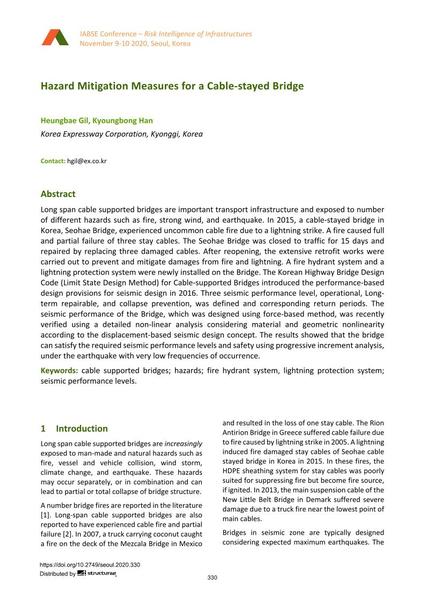Hazard Mitigation Measures for a Cable-stayed Bridge

|
|
|||||||||||
Bibliographic Details
| Author(s): |
Heungbae Gil
(Korea Expressway Corporation, Kyonggi, Korea)
Kyoungbong Han (Korea Expressway Corporation, Kyonggi, Korea) |
||||
|---|---|---|---|---|---|
| Medium: | conference paper | ||||
| Language(s): | English | ||||
| Conference: | IABSE Conference: Risk Intelligence of Infrastructures, Seoul, South Korea, 9-10 November 2020 | ||||
| Published in: | IABSE Conference Seoul 2020 | ||||
|
|||||
| Page(s): | 330-337 | ||||
| Total no. of pages: | 8 | ||||
| DOI: | 10.2749/seoul.2020.330 | ||||
| Abstract: |
Long span cable supported bridges are important transport infrastructure and exposed to number of different hazards such as fire, strong wind, and earthquake. In 2015, a cable-stayed bridge in Korea, Seohae Bridge, experienced uncommon cable fire due to a lightning strike. A fire caused full and partial failure of three stay cables. The Seohae Bridge was closed to traffic for 15 days and repaired by replacing three damaged cables. After reopening, the extensive retrofit works were carried out to prevent and mitigate damages from fire and lightning. A fire hydrant system and a lightning protection system were newly installed on the Bridge. The Korean Highway Bridge Design Code (Limit State Design Method) for Cable-supported Bridges introduced the performance-based design provisions for seismic design in 2016. Three seismic performance level, operational, Long- term repairable, and collapse prevention, was defined and corresponding return periods. The seismic performance of the Bridge, which was designed using force-based method, was recently verified using a detailed non-linear analysis considering material and geometric nonlinearity according to the displacement-based seismic design concept. The results showed that the bridge can satisfy the required seismic performance levels and safety using progressive increment analysis, under the earthquake with very low frequencies of occurrence. |
||||
| Keywords: |
cable-supported bridges hazards fire hydrant system lightning protection system seismic performance levels
|
||||
